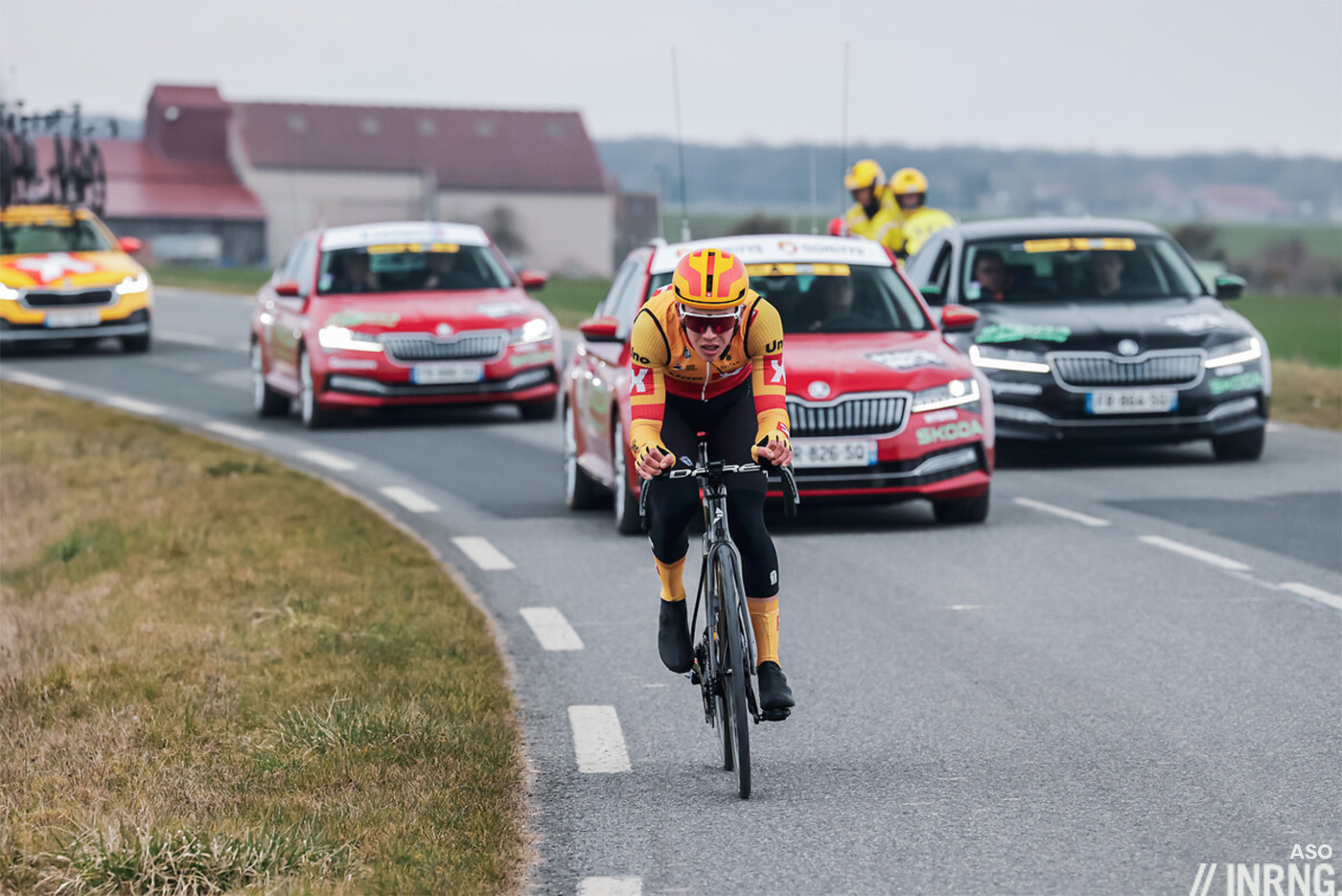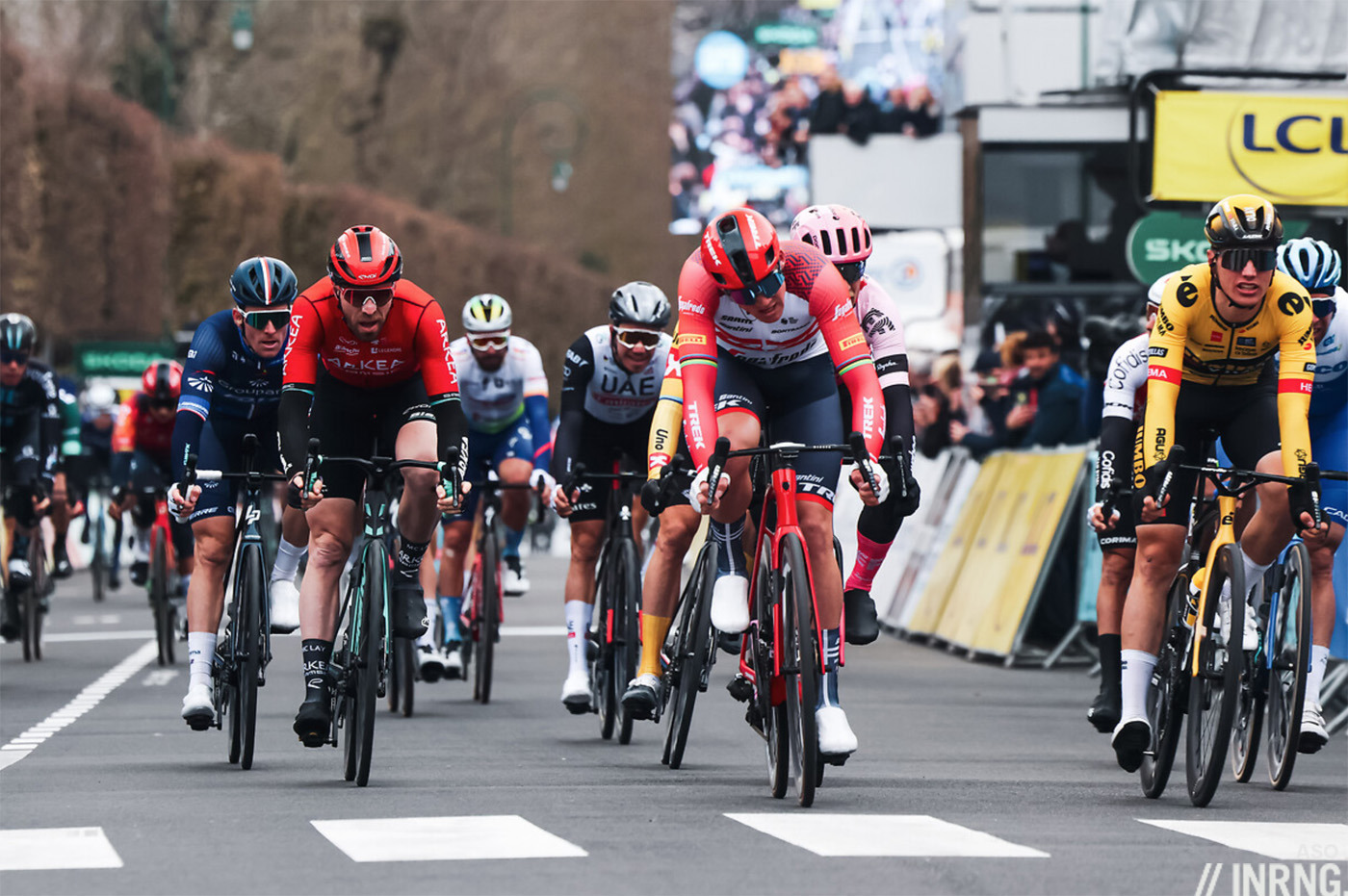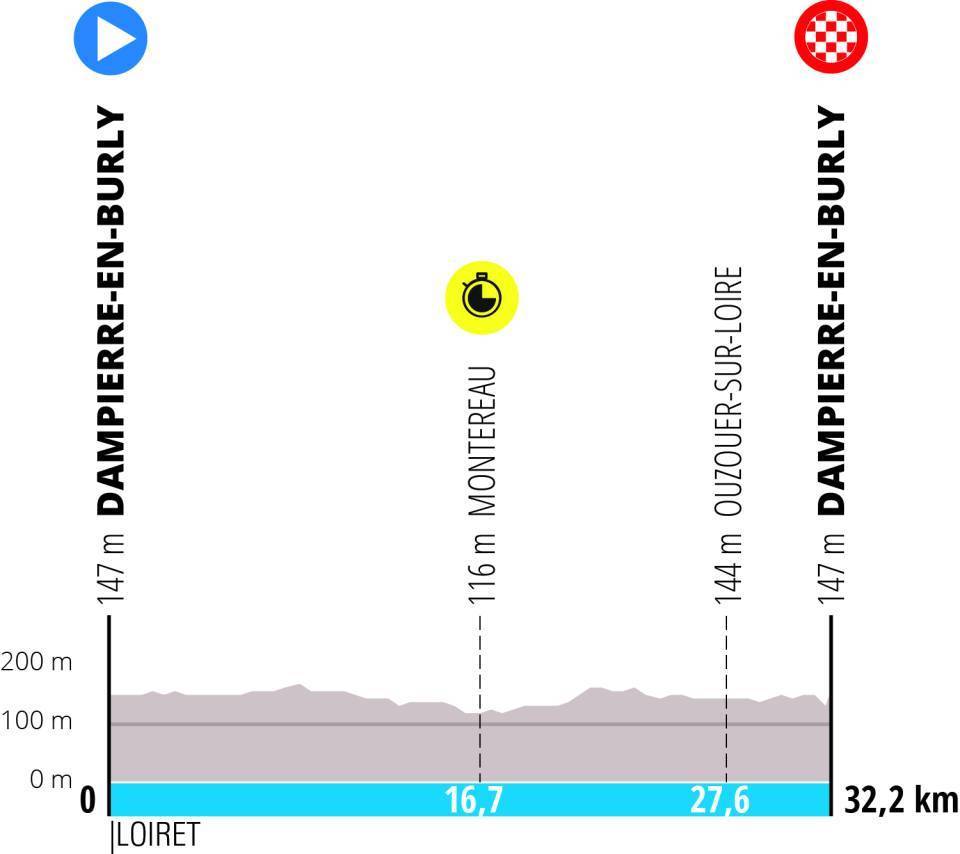The team time trial stage with that novel rule change that’s still a team time trial. How much of a lead can Jonas Vingegaard get on Tadej Pogačar today?

Remember sprint trains?: first a quick mention of Jonas Gregaard who drew the short straw and went a solo attack but got the mountains jersey for his efforts, helped by his attack on Sunday. With fewer and fewer teams actually being invited to races there’s less onus on them to provide “animation” but Uno-X duly supplied a rider to go up the road for the day, even if they had a contender for the stage in Alexander Kristoff.
Remember sprint trains, when a sprinter could hitch a ride on the back of several team mates and bid their time until the finish? Perhaps it started with the Flandria team in the 1970s, it became the way the Saeco team won in the 1990s and probably reached perfection with the HTC/Highroad team around 2009. These days teams still have lead outs and riders to guide them through the finish but no one team is able to control the race like times past. You can see it, the front of the peloton is not strung out in a line, nor even in arrow formation but often spread across the road – which can sometimes be a sign of a go-slow but obviously is quite the opposite with there’s 800m to go in a World Tour race, everyone is trying to get to the front.
Mads Pedersen got the win, helped by a lead-out into the finish from Alex Kirsch, and he just seemed the fastest in the finish and collects the yellow jersey thanks to being third on Sunday’s stage as well.

The Route: 32km around Dampierre-en-Burly, a small town close to the banks of the Loire river and dominated by France’s sixth biggest nuclear power station with its four reactors and their cooling towers which have been in the news of late, partly because of long maintenance saw them being closed just as energy prices were spiking going into winter; and also last summer when the Loire was running dry and they were wondering if the plant could return water used for cooling back to the river of whether this would make what was left in the river too hot to sustain wildlife.
Anyway the course is largely flat with 180m of vertical gain, triangular in shape and it suits big engines who can pull at 60km/h rather than teams that can plot their way around a technical course. The start and finish are at the base of the triangle, the zone north of this is woodland offering some shelter from the wind and the peak of the triangle is exposed. There seven bends and most of them can be taken at speed in the tri-bars, otherwise it’s long straight sections which often roll up and down. The hardest drag up comes with about 10km to go.
The Rules: the novelty here is the time is taken on the first rider to cross the line and each rider gets credited with the time it takes them to complete the course. This means two things:
- a team is no longer as fast as its fourth or fifth rider, it doesn’t have to finish as a group. If one rider sprints solo to the line and sets the fastest time, their team wins the stage
- a team with a specialist rouleur can let them go off the front to get the stage win but if they have a GC rider as well, then they get the time they cross the line with. Therefore teams with ambitions for the overall have to guide their leaders to the best time possible
You can imagine the tactics with teams in formation for the first part of the course but the closer the finish gets, the more likely they burn up riders who can take pulls that put them into the red while towing their team that bit faster.
Artifice, a gimmick? Perhaps but so is a team time trial based on the time of the fourth rider as well. It probably won’t change too much either although it gives us something to think about on a Tuesday in March. Paris-Nice actually has a long history of innovation and rule changes, some like air transfers, prologues and the one/three kilometre rule all come from this race and are features, others like the “best descender prize” have not stuck.

The Contenders: Jumbo-Visma have picked a team with this stage in mind and the idea to get Jonas Vingegaard not just in the lead but with a cushion on his rivals including Tadej Pogačar. They have the reigning world TT champ in Tobias Foss, former world champ Rohan Dennis, the wardrobe-sized TT specialist Edoardo Affini and Jonas Vingegaard won a TT in the Gran Camino.
Ineos have a very strong team, although just imagine if they’d brought Filippo Ganna and a couple of others. Next come a sweep of teams who ought to be close but it’d still be a surprise if they won. Soudal-Quickstep. EF Education-Easypost where just pipped in the UAE Tour, although only rider in Marijn van der Berg, is here from that day. Bahrain. Bora-hansgrohe. Jayco-Al Ula.
UAE have their work cut out. Tadej Pogačar has only done one team time trial since turning pro and in the 2019 Vuelta a España his UAE team finished 21st out of 22. However this was a day when Jumbo also lost time, a leak of water on the course caused carnage. Still team management are getting the excuses in, saying they didn’t have TT bikes over the winter because of equipment shortages, a reminder that while the heritage fades, it’s still the old Lampre team at times and you can’t imagine other teams having this problem.
| Jumbo-Visma | |
| Ineos | |
| EF, Quickstep, Bora |
Weather: cold and cloudy, 7°C and a light SW wind.
TV: the first team is off at 2.15pm CET, TV coverage starts an hour later and the last team should arrive at 4.40pm CET.


Is it really an innovation? I seen to recall Tour of the Med experimenting with this TTT format a decade ago on Mont Faron. Also didn’t the Hammer series/tour also have something similar?
Paris-Nice has a lot of innovation over the years, but as you say this is more of an import.
Mont Faron could be more fun to use it, a flat course that leads into a hill so teams have to tow their leader and then they charge up the hill to set the time.
When I first heard about this year Paris Nice TTT then I wondered if the format might be linked with comments Prudhomme made last October, to the effect of time trials bringing poor tv numbers. I wondered if they are trying to play with the format to spice it up and get more viewers. For example maybe we can expect something like this in the last stage of next years tour with a TTT around Nice, then up Col d’Èze and finish on Promenade des Anglais with times taken on an individual basis. Just an idea.
On a side note I have always wondered if a ‘pursuit’ style race like we have in Cross country skiing/biathlon would work in a 3 week tour. Where the riders start individually based on their time in GC with the new GC times taken based on the finish of that stage, so you could effectively have a situation where the entire race GC comes back to being on the same time by the end of the stage. It might seem unfair if a rider builds up a nice GC lead only for it to all fall away on one stage due to riders coming together, forming a large peloton which just eats up all the riders into one group, but that is risk they take. It might work in the middle of a 3 week race to help bunch up the GC again heading into the final mountains. Also the stage could be run over a course that does not always favour the power of a fast moving peloton such as multiple short technical climbs/downhills, twisty thin roads like you have in Flanders, Ardennes, Dordogne, Cantal, Coreze etc
“…others like the “best descender prize” have not stuck.” Can you point me to more on that? I thought it was the Giro d’Italia’s infamous Poggio downhill time trial and most recently their ill-fated Pirelli-sponsored best descender prize that encouraged derring-do only to be shouted down and scrapped.
Paris-Nice had a best descender prize for one year only in 1968, the winner got ski equipment and cash. It was won by Lucien Aimar, but never came back. As you say the Giro reprised the idea but after some blogger pointed it out several riders made representations to RCS and it was dropped.
Thanks! I find it kind of odd that the sport celebrates so much the going uphill but other than the exceptions we’ve pointed out (all failures) they sort of turn a blind eye towards the going down.
I don’t doubt most like to watch the derring-do but back away from any sort of official encouragement so their a__es are covered in the event of a tragedy?
I guess it is viewed as encouraging dangerous behavior, pushing the riders to take more risk than acceptable. I would argue that sprint finishes in grand tours are at least as dangerous and also more dangerous to riders not personally trying to stay in the front. Still, there are stage wins and even monument wins available for those who dare to take risks.
Did you see Pidcock’s recent viral descending video somewhere in California? (Well worth finding if you haven’t) I was shaking my head at the hand-wringers saying it was encouraging recklessness, that the team would not be happy with him etc. Then low and behold, his descending gets him the gap in Strade and puts him in a the position to win the race. Bring on the Poggio!
I saw that one, I am happy it was a one-way street 😉
Several dare-devil descents to be found on YT; Sagan, Cancellara, Simoni et al.
On the RCS reprise prize, also the subject of following (in front) vehicles is a major safety issue. The riders – for the most – know how to take the calculated risks and could probably have accepted the competition but when introducing cars and drivers into the equation…
Yes, it was a one-way street so not as wild as some thought it was.
We’ll see for the Poggio, a skilled descender can get a gap but it’s not that technical actually. What works is having real power as well, you can carry some speed in and out of corners with skill but being able to sprint out of the few corners is what counts too. It’s why Peter Sagan really should have won the race, he can descend and he has the power but it never quite happened.
As for the descending prize, it was based on timed segments downhill and the problem was riders aiming for the prize wouldn’t know who they were racing against, the first rider over a mountain pass could ace the descent and take two minutes on their rivals on the way down… only to find the prize went to someone from the gruppetto who didn’t just descend like a stone but surfed cars in the convoy as UHJ suggests.
I remember the Giro’s crazy idea and it did not help that Chad Young died descending less then a month before the announcement.
I wonder if Mr Ring remembers who “some blogger” was … modesty may cloud your memory!
We know that Jayco practice on their time trial bikes so I am tipping them fir third on the stage to put Yates in contention for third overall.
Wonder if Ineos will allow Josh Tarling to try for the stage or if he will be on team duty.
The current state of lead out teams not only gives weight to those specialist lead out riders like van poppel but also exposes those riders who need a good lead out to be consistent. Sprinters who can push through are worth much more in this environment.
Those fast sprinters who can’t fight there way through to the good posi by themselves and don’t have at least one super lead out rider only rarely end up sprinting from a good position. Ewan would be a candidate often getting relegated back and sprinting from a bad position.
I was thinking this yesterday, with De Lie coming from quite far back. A Lotto problem? Though it seems unfair to lay the blame on the team too much here, given the chaos of that sprint in general.
(Also, good to see Dan McLay making representations at the front. Hope he gets a few chances for himself this year).
It seems like a novelty that there is a team time trial, indeed any time trial, on open fast roads over a relatively longish distance. On roads actually suited to a time trial. Not in a town centre, with no cobbles, no bike lane, no footbridge, no dead turns or a 15% climb up to a church. I approve.
It would also be a novelty to have a sprint on a wide straight boulevard apart from the Champs Elysees. There was one stage of last year’s Giro like that, but sprinting may no longer be done in team trains simply because of course design, abundance of roundabouts and street furniture. These days the races go to airports and motor circuits for full sprints, which is not ideal for organisers who get fees from the Ville d’Arrivee.
+1 I like the TTT as it’s a “horses for courses” decision the directors have to make. Bring a bunch of real gallopers to help your GC man vs skinny climbers to help him elsewhere, though I still wish they’d ditch the chrono bikes and screwball handlebars to get rid of rich team’s wind-tunnel testing and the advantage of the dreaded “kite men”.
Every second counts, Pogacar reportedly said after yesterday’s stage, and for him and UAE it was “Mission Accomplished” with getting those 12 bonus seconds.
Baring accidents or bad weather, Jumbo should win though Ineos and QS always do well at TTT’s. The big question is how well (and how) UAE do.
Just noticed on pcs, there has been only five ttts at World tour level in the last five years.
Sprint trains go back at least as far as Rik I and Solo-Superia’s Red Train back in the early 1960’s.
Now it is the case that a lot of teams try to have a sprint train so the differences between them are less pronounced. They will spread across the road trying to get the best position and thereby often cancel each other out. In races where one train is clearly dominant the old arrowhead formation and armchair ride for the sprinter can still be seen.